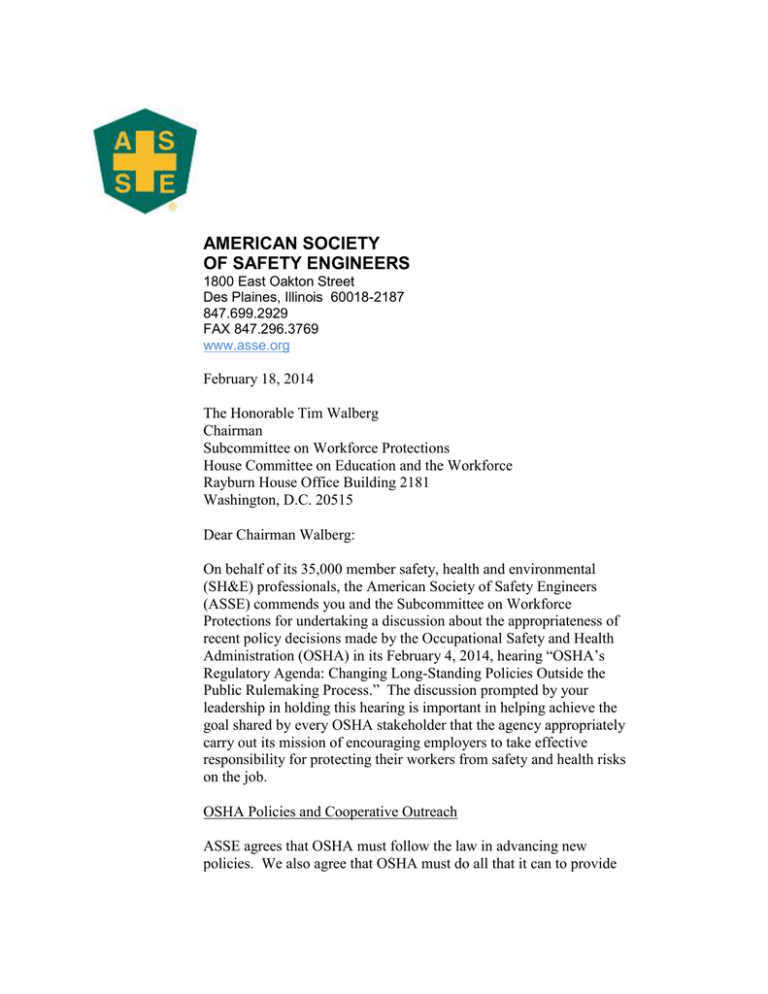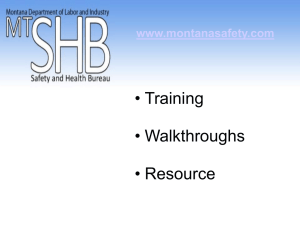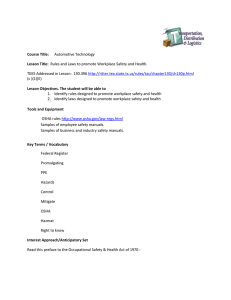American Society of Safety Engineers
advertisement

AMERICAN SOCIETY OF SAFETY ENGINEERS 1800 East Oakton Street Des Plaines, Illinois 60018-2187 847.699.2929 FAX 847.296.3769 www.asse.org February 18, 2014 The Honorable Tim Walberg Chairman Subcommittee on Workforce Protections House Committee on Education and the Workforce Rayburn House Office Building 2181 Washington, D.C. 20515 Dear Chairman Walberg: On behalf of its 35,000 member safety, health and environmental (SH&E) professionals, the American Society of Safety Engineers (ASSE) commends you and the Subcommittee on Workforce Protections for undertaking a discussion about the appropriateness of recent policy decisions made by the Occupational Safety and Health Administration (OSHA) in its February 4, 2014, hearing “OSHA’s Regulatory Agenda: Changing Long-Standing Policies Outside the Public Rulemaking Process.” The discussion prompted by your leadership in holding this hearing is important in helping achieve the goal shared by every OSHA stakeholder that the agency appropriately carry out its mission of encouraging employers to take effective responsibility for protecting their workers from safety and health risks on the job. OSHA Policies and Cooperative Outreach ASSE agrees that OSHA must follow the law in advancing new policies. We also agree that OSHA must do all that it can to provide 2 employers and workers with as much information as possible when a new or changed policy is advanced. Often, the changes are legal in nature and beyond the ability of many small and medium sized employers to interpret and understand. Our members provide the employers with whom they work the ability to meet any new OSHA policy or standard, but most employers are not able to engage a safety and health professional. For those employers especially, OSHA has developed significant capacity in its cooperative programs to work with industry trade groups and individual partners like ASSE to communicate to employers on a variety of issues. These important relationships need to be used to communicate clearly any new expectations on employers. We do not believe this has been adequately done to date and encourage OSHA to do so. Advancing the Rulemaking Process The hearing was also beneficial in providing an opportunity to discuss the limitations OSHA faces in its efforts to be an effective regulatory agency. ASSE has never been an organization that believes a new standard is the answer to a workplace risk. Our members typically approach workplace safety by, as they say, “managing the risk, not the standard.” Yet, when a standard can significantly advance workplace protections, does not unduly burden employers, and is consistent with how our members already manage the risks a standard seeks to address, we have supported new or revised standards. From that measured perspective, ASSE has no difficulty in telling the Subcommittee that the time has long passed when Congress needed to give OSHA the tools it needs to more reasonably advance its rules. For the most part, the companies our members work with already protect workers at more protective levels than those required by OSHA’s dated standards. The inconsistency between the safety and health profession’s best practices and OSHA’s standards in too many areas creates only repetitive and inconsistent bureaucratic demands on employers and our members. Without the ability to keep up with relevant standards, OSHA itself faces the threat of being increasingly irrelevant in a world where companies more and more are focused on international and voluntary consensus standards that respond more readily to current industry practices. While many of our members are already far more focused on these other drivers of occupational safety and health practices, OSHA standards remain vitally important to help encourage employers who do not understand the value of safety and health in today’s marketplace. With dated standards, OSHA fails both them and the workers for whom they are responsible. Measures to ease the punishing process any OSHA rulemaking must endure to advance to a final rule are a significant part of the Draft Occupational Safety and Health Reform Bill that ASSE developed to provide a basis for compromise in 3 Congress to bring the Occupational Safety and Health Act of 1970 into the 21st Century. Those measures include Advancing risk-based a regulatory approaches. The proscriptive nature of OSHA’s standards have only taken us so far in protecting workers. In having to determine such extremely specific requirements that employers must follow to meet a standard, OSHA has been given a task that takes far too difficult to accomplish in a reasonably timely way. Risk-based standards that focus on setting expectations and not necessarily the specific means for achieving those expectations can better encourage employers, working with safety and health professionals, to take full responsibility for developing better ways to meet a standard. Encouraging collaborative rulemaking. Our members appreciate the effectiveness of collaboration in voluntary consensus standard-setting process. We have proposed that the GAO study the effectiveness of the very similar process of negotiated rulemaking, with the goal of implementing more collaborative, less contentious ways to pursue OSHA rulemaking. Enabling OSHA to update standards with voluntary consensus standards. Now, OSHA must engage in the rulemaking process to keep pace with widely accepted safety and health voluntary consensus standards that better reflect safety and health professionals’ best understanding about how to protect workers. The Based on an OSHA proposal, OSHA could better keep in step with accepted industry practices, encourage consistent standards throughout industry, and make more efficient the standard-setting process. These measures do not exhaust the possible changes that can be made to encourage a more reasonable but still measured process to help OSHA be more effective. With a more reasonable rulemaking process, we would also hope that OSHA would be encouraged to develop new policies through the rulemaking process. The difficulties of the current process only encourage OSHA to avoid it when possible, no matter its benefits in providing a platform to involve stakeholders. Please Do One Thing ASSE appreciates and is encouraged by your closing comments indicating a desire to work with your minority colleagues in the Subcommittee to address the difficulties raised at the hearing. As mentioned above, we encourage you to take a look at the measures we have put forward in our Draft Occupational Safety and Health Reform Bill, which contains ideas from both side of the political debate on occupational safety and health that ASSE has supported over the years. We believe it can serve as a catalyst for negotiation that can advance a variety of widely supported ideas to improve occupational safety and health protections for this nation’s workers. 4 From our various discussions on Capitol Hill in both Republican and Democratic offices, with OSHA and with the National Institute for Occupational Safety and Health (NIOSH), it is apparent to us that a real consensus has developed that bipartisan agreement can be reached on allowing OSHA to update its Permissible Exposure Limits (PELs). As you know, in previous Congresses, updating PELs was the best hope of your predecessor as Chairman of the Subcommittee, Representative Charlie Norwood (R-GA). We urge you to take up the fight he thoughtfully began and, if no other measure can be advanced in occupational safety and health during this Congress, that you use your leadership to make sure that this measure does. As with many other OSHA standards, our members and the employers with whom they work have long since used levels of protection far above OSHA’s PELs. The proposal we included in our draft bill would require OSHA to adopt NIOSH relative exposure limits (RELs), which, as you know, are widely accepted and respected. This is one approach. We would be more than happy to support other measures that can fix this fundamental fault in the nation’s ability to provide reasonable, relevant oversight of workplace safety and health. Please, we urge you to do this one thing. Conclusion Again, thank you for this opportunity to comment. If there is anything that ASSE and our members can do to help continue the discussion begun in this hearing, we encourage you to reach out to us. Beyond the variety of views of how best OSHA should pursue its mission, ASSE’s member safety and health professionals may be the stakeholders who best understand the impact of OSHA’s decisions on both employers and workers. We appreciate your having listened to them. Sincerely, Kathy A. Seabrook CSP, CMIOSH, EurOSHM President cc: The Honorable Joe Courtney Ranking Member




